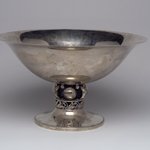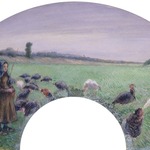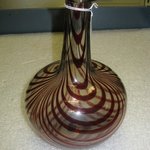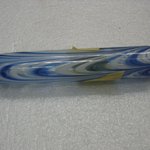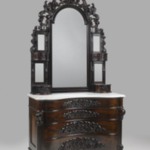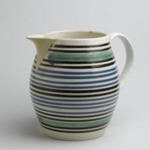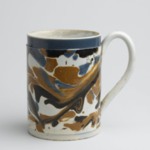
Stand
Decorative Arts and Design
This is a very early example of the use of bent tubular metal to make furniture, a technique more often associated with twentieth-century modernist design (particularly Marcel Breuer’s tubular steel furniture, produced by Thonet in the mid-1920s). Bradley & Hubbard were also pioneers of a progressive manufacturing technique known as the interchangeability of parts. Some of the decorative elements on this table were also used in their brass lighting devices. Casting a large number of the same parts at once and incorporating them into many different designs saved time and money and streamlined production. This innovative, wholly modern process foretold the manufacturing methods of the twentieth century.
MEDIUM
Brass, glazed earthenware
GEOGRAPHICAL LOCATIONS
- Place made: Meurthe-et-Moselle, France
- Place manufactured: Meriden, Connecticut, United States
DATES
1885
DIMENSIONS
32 13/16 x 13 3/8 x 13 3/8 in. (83.3 x 34.0 x 34.0 cm) (show scale)



MARKINGS
Molded on underside of table top: "PAT' APL'D FOR"
COLLECTIONS
Decorative Arts and Design
ACCESSION NUMBER
1998.45
CREDIT LINE
Gift of the American Art Council
CATALOGUE DESCRIPTION
Stand or pedestal, cast brass and polychrome glazed earthenware, Aesthetic Movement style. Square brass top of stand inset with ceramic tile; wide brass frame around tile decorated with highly polished, stylized floral motifs and egg-and-dart borders; bottom edge scalloped. Tile has ground of turquoise blue with large stylized floral motif in center surrounded by smaller floral and foliate motifs; colors include light and dark blues, yellow, greens, pinks, and white; glazing imitates cloisonné. Top of stand supported on elaborate brass shaft of multiple parts and four legs. Top of shaft (which supports tabletop) consists of inverted squat pyramidal form pierced with floral designs attached to top of stand with screws. Short tubular piece connects pyramid to baldachin-like form of a dome atop wider cylindrical drum; dome and drum covered with stylized floral designs. Four narrower tubular "stems" ringed with several bands rise up from drum, taper, and terminate in bowl-shaped flowers with scalloped edges and bead centers. The tubular stems extend downward through drum forming narrow columns which run to cylindrical drum base; base decorated like baldachin. Atop this base and set within the four columns is a pierced cylindrical gallery supporting a glazed earthenware cylinder or canister. Canister decorated with ground of turquoise blue and is covered with several large peony-like flowers in pink and peach and stylized foliate motifs in dark blue and white. Canister is topped by a shallow brass dome and baluster-like finial with flaring saucer shape at top. The shaft of the stand is raised on four, tubular brass legs, attached to the drum base; each leg is an inverted "L" shape terminating in a domed foot with floral decorations; a strap runs diagonally across the corner of each leg; atop the horizontal member of each leg bracket is an upright triangular fin decorated with geometric patterns, and pierced holes and a scalloped edge along one side. Various parts attached with screws and bolts.
Condition: Good
EXHIBITIONS
MUSEUM LOCATION
This item is not on view
CAPTION
Bradley & Hubbard Manufacturing Company (active 1854–1940). Stand, 1885. Brass, glazed earthenware, 32 13/16 x 13 3/8 x 13 3/8 in. (83.3 x 34.0 x 34.0 cm). Brooklyn Museum, Gift of the American Art Council, 1998.45. Creative Commons-BY (Photo: Brooklyn Museum, 1998.45_SL3.jpg)
IMAGE
overall, 1998.45_SL3.jpg. Brooklyn Museum photograph
"CUR" at the beginning of an image file name means that the image was created by a curatorial staff member. These study images may be digital point-and-shoot photographs, when we don\'t yet have high-quality studio photography, or they may be scans of older negatives, slides, or photographic prints, providing historical documentation of the object.
RIGHTS STATEMENT
Creative Commons-BY
You may download and use Brooklyn Museum images of this three-dimensional work in accordance with a Creative Commons license. Fair use, as understood under the United States Copyright Act, may also apply.
Please include caption information from this page and credit the Brooklyn Museum. If you need a high resolution file, please fill out our online application form (charges apply).
For further information about copyright, we recommend resources at the United States Library of Congress, Cornell University, Copyright and Cultural Institutions: Guidelines for U.S. Libraries, Archives, and Museums, and Copyright Watch.
For more information about the Museum's rights project, including how rights types are assigned, please see our blog posts on copyright.
If you have any information regarding this work and rights to it, please contact copyright@brooklynmuseum.org.
RECORD COMPLETENESS
Not every record you will find here is complete. More information is available for some works than for others, and some entries have been updated more recently. Records are frequently reviewed and revised, and we welcome any additional information you might have.





























